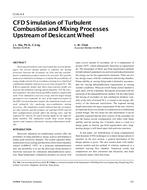Description
Direct gas-fired desiccant reactivation has several advantages, but several design options to enhance the mixing processes between the secondary air (SA) and the stoichiometric combustion products need to be assessed. We used the numerical simulation technique to evaluate the possibilities of using a high-velocity SA jet to enhance mixing in a cylindrical combustion chamber with an excess air ratio around 28:1. The k– e two-equation model and three-step-reaction model are used for the turbulent reacting and mixing flow. For the reaction dynamics, the eddy-break-up (EBU) model is empirically used. Four simulation cases are set up, and two major design parameters are evaluated. In view of the empirical nature of the EBU reaction dynamics model, the simulation results were used primarily for analyzing post-combustion mixing processes. The simulation results indicate that the secondary air inlet velocity and the primary air and fuel (PAF) and SA inlet configurations greatly affect the mixing rates, and the required SA velocity for quick mixing might be too high for flame stability. The simulation results help screen design options and compare alternative mixing enhancement methods.
Units: Dual
Citation: Symposium, ASHRAE Transactions, vol. 107, pt. 2
Product Details
- Published:
- 2001
- Number of Pages:
- 8
- File Size:
- 1 file , 510 KB
- Product Code(s):
- D-7056




